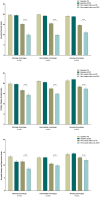Digital cognitive behaviour therapy for insomnia (dCBT-I): Chronotype moderation on intervention outcomes
- PMID: 35224810
- PMCID: PMC9787033
- DOI: 10.1111/jsr.13572
Digital cognitive behaviour therapy for insomnia (dCBT-I): Chronotype moderation on intervention outcomes
Abstract
Using data from 1721 participants in a community-based randomized control trial of digital cognitive behavioural therapy for insomnia compared with patient education, we employed linear mixed modelling analyses to examine whether chronotype moderated the benefits of digital cognitive behavioural therapy for insomnia on self-reported levels of insomnia severity, fatigue and psychological distress. Baseline self-ratings on the reduced version of the Horne-Östberg Morningness-Eveningness Questionnaire were used to categorize the sample into three chronotypes: morning type (n = 345; 20%); intermediate type (n = 843; 49%); and evening type (n = 524; 30%). Insomnia Severity Index, Chalder Fatigue Questionnaire, and Hospital Anxiety and Depression Scale were assessed pre- and post-intervention (9 weeks). For individuals with self-reported morning or intermediate chronotypes, digital cognitive behavioural therapy for insomnia was superior to patient education on all ratings (Insomnia Severity Index, Chalder Fatigue Questionnaire, and Hospital Anxiety and Depression Scale) at follow-up (p-values ≤ 0.05). For individuals with self-reported evening chronotype, digital cognitive behavioural therapy for insomnia was superior to patient education for Insomnia Severity Index and Chalder Fatigue Questionnaire, but not on the Hospital Anxiety and Depression Scale (p = 0.139). There were significant differences in the treatment effects between the three chronotypes on the Insomnia Severity Index (p = 0.023) estimated difference between evening and morning type of -1.70, 95% confidence interval: -2.96 to -0.45, p = 0.008, and estimated difference between evening and intermediate type -1.53, 95% confidence interval: -3.04 to -0.03, p = 0.046. There were no significant differences in the treatment effects between the three chronotypes on the Chalder Fatigue Questionnaire (p = 0.488) or the Hospital Anxiety and Depression Scale (p = 0.536). We conclude that self-reported chronotype moderates the effects of digital cognitive behavioural therapy for insomnia on insomnia severity, but not on psychological distress or fatigue.
Keywords: chronotype; circadian preferences; digital cognitive therapy for insomnia; insomnia; moderator; randomized-controlled trial.
© 2022 The Authors. Journal of Sleep Research published by John Wiley & Sons Ltd on behalf of European Sleep Research Society.
Conflict of interest statement
LMR report financial or business interests in BeHealth Solutions and Pear Therapeutics, two companies that develop and disseminate digital therapeutics (including by licensing the therapeutic developed) based in part on early versions of the software from the University of Virginia, which is used in the research reported in this article. These companies had no role in preparing this manuscript. LMR is also a consultant to Mahana Therapeutics, a separate digital therapeutic company not affiliated with this research. All other authors declare no competing interests.
Figures

References
-
- Adan, A. , & Almirall, H. (1991). Horne and Ostberg Morningness Eveningness Questionnaire ‐ a reduced scale. Personality and Individual Differences, 12(3), 241–253. 10.1016/0191-8869(91)90110-W - DOI
-
- Asarnow, L. D. , Bei, B. , Krystal, A. , Buysse, D. J. , Thase, M. E. , Edinger, J. D. , & Manber, R. (2019). Circadian preference as a moderator of depression outcome following cognitive behavioral therapy for insomnia plus antidepressant medications: A report from the TRIAD study. Journal of Clinical Sleep Medicine, 15(4), 573–580. 10.5664/jcsm.7716 - DOI - PMC - PubMed

